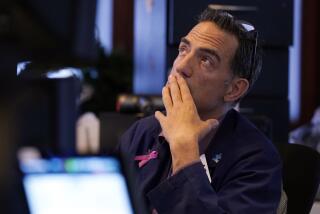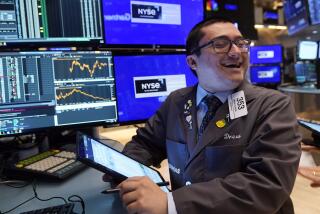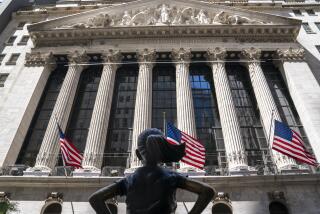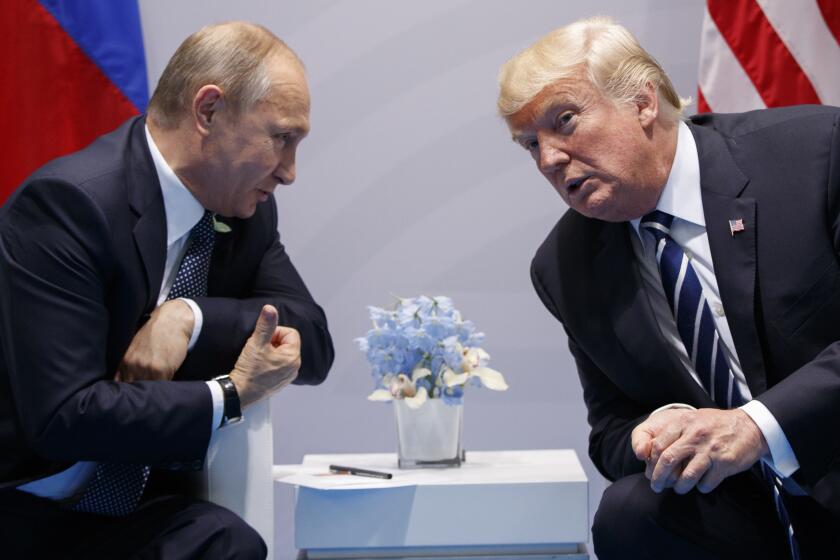Nikkei Index Continues on Its Wild Ride
- Share via
TOKYO — The stock market gave investors another white-knuckle ride on Monday, this time on the up side, and economists trotted out theories ranging from higher taxes to the government’s promised “Big Bang” reforms to explain the worrisome performance of the Nikkei index.
The 225-stock Nikkei plunged 10.6% last week, including a 4.26% fall on Friday, then roared back with a 4.71% gain Monday. In early trading today, it headed south again.
The Nikkei’s wild gyrations, analysts here say, illustrate two key facts about the market that push in opposite directions: Stocks are still vulnerable to concerns about the massive bad loans plaguing the Japanese banking system, but the Japanese government has enormous power to prop up the market--if it decides to do so. And that was the question of the moment.
Last week’s plunge was led by bank stocks, and Monday’s recovery was likewise led by the banking sector, which rose 6.7% and included seven of the 10 most active issues.
Monday’s surge was widely described as mainly a rebound effect to Friday’s fall, and today, the Nikkei was down 446.50 points, or 2.46%, to 17,672.29. Bank and brokerage stocks led the newest falloff.
Officially, the government continued to maintain a strictly hands-off policy toward stock prices, in line with a pledge by Prime Minister Ryutaro Hashimoto to push forward with broad deregulation of Japan’s economy. But a hint by a leading politician that the government might boost the market, combined with rumors that it had already begun to do so, played a supporting role in Monday’s dramatic climb.
The Nikkei index dropped to an early low of 17,019.56 on Monday, then bounced back an extraordinary 1,099.23 points to close at 18,118.79. That left it up for the day by 815.14 points, or 4.71%.
The rally gained strength from a Jiji news agency report that Koichi Kato, secretary-general of the ruling Liberal Democratic Party, had said the government should take action to support stock prices. Later in the day, some traders said an inflow of government-controlled money also was helping to push up prices.
The market decline actually began in early December, and through Friday the index had tumbled 21%. The episode was triggered largely by cabinet approval of a budget for the fiscal year beginning April 1 that calls for higher taxes and a lower deficit, which means less fiscal stimulus for the economy. That step is defended by officials as necessary to put Japan’s long-term government finances in order.
Many analysts also say the plunge was exacerbated by concerns about Hashimoto’s proposed “Big Bang” financial reforms, which aim to create a much less regulated and more highly competitive financial market in Tokyo by the year 2001.
Hashimoto named his mid-November proposals after a set of British reforms carried out in 1986 that revitalized London markets and were known as “the Big Bang.” Some critics, noting that Japan plans five years for its reforms, have dubbed them “the Slow Fizzle.”
In a reflection of the stock market’s current confusion, some analysts say investors fear the effect of “Big Bang” deregulation on bank profits--while others claim that investors fear the financial reforms will not be implemented quickly enough.
The proposed “Big Bang” would gradually ease various controls and let banks, insurance companies and securities firms compete more freely with each other. One of its purposes is to let stronger institutions prosper while weeding out the weaker ones through mergers or carefully controlled bankruptcies.
This is a process seen by many analysts as necessary for Japan’s long-term economic health, but bound to be painful.
The Japanese banking system is burdened by about $260 billion in bad loans, according to official estimates, and some private analysts say the real figure could be twice that much. Many banks hold large amounts of stocks in other firms, and whenever the value of stocks has been high enough, they have used profits from stock sales to write off some of this bad debt.
These bad debts were mainly caused by the twin collapse of stock and real estate prices in the early 1990s.
The Nikkei index hit an all-time high of 38,915.87 at the end of 1989, during the peak of Japan’s “bubble economy,” then plunged after authorities raised interest rates to cut off what they considered an unsustainable rise in asset values. The index fell to a low of 14,309.47 on Aug. 18, 1992, when its slide was finally stopped through various forms of government intervention.
Since then, the index has moved back and forth between a fairly well-defined floor and a ceiling. When the index approaches the floor of about 14,500, stocks have been supported by government intervention. When it hits the ceiling of about 22,000, the rise is blocked by profit-taking.
When stocks fall, that makes it harder for banks to write off their bad loans. Lower stock values also could make consumers and corporations less likely to spend, which could bring slower economic growth and further pressure on stock prices.
But there are limits to how far any such downward spiral is likely to go.
Despite its hands-off vow, “nobody believes the government wouldn’t step in,” said David Threadgold, a banking analyst at BZW Securities.
“It’s just a question of at what level would they step in. Let’s face it: They don’t believe in free markets, they never have, they haven’t suddenly become converts. At 14,000, I’m sure they’d step in. It’s not as if there’s any matter of principle involved here.”
During previous downturns in the Nikkei index, some observers have expressed fear that a downward spiral could prompt Japanese banks and insurance companies to repatriate assets from abroad to cover losses at home, thereby triggering higher U.S. interest rates and a fall in U.S. stocks.
Most analysts in Tokyo, however, now discount such a scenario for a variety of reasons. For one thing, the economy and the banking system, whatever their weaknesses, are generally seen as in better shape now than in the market’s prior falloffs.
“The condition of the Japanese financial system is not that bad,” said Alicia Ogawa, a banking analyst at Salomon Bros. Asia Ltd. “It’s not a meltdown scenario. . . . I thought at close of trading Friday most banks were trading at what I would call fair value.”
The government has a variety of immensely powerful tools--including some $4 trillion in postal savings, public pension and insurance assets--it can use to support stock prices and thereby prevent any financial upheaval that might lead to large-scale repatriation of foreign assets.
Jesper Koll, head of economic and markets research at J.P. Morgan Securities Asia Ltd., said the greater risk is not a Japanese withdrawal of assets from overseas, but too much Japanese capital fleeing Japan in pursuit of higher profits abroad. Overseas assets are currently showing better returns than domestic assets, he and other analysts noted.
Koll predicted that major government intervention would not take place unless the Nikkei fell below 15,500, and that the most likely form of action in that case would be for the Bank of Japan to increase the economy’s overall money supply.
“Japan’s financial system is not going to be allowed to fail,” Koll said. “There might be some mergers. There might be some bankruptcies. Is there a systemic risk? No.”
(BEGIN TEXT OF INFOBOX / INFOGRAPHIC)
A Wide Ride
The 225-stock Nikkei index plunged 10.6% last week but recovered 4.7% on Monday. Quarterly closes of the Nikkei, plus latest, in thousands:
Monday: 18.8, +0.8%
Source: Bloomberg News
More to Read
Sign up for Essential California
The most important California stories and recommendations in your inbox every morning.
You may occasionally receive promotional content from the Los Angeles Times.










